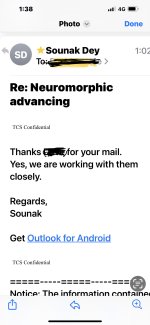Yes, Rskiff,....that is pretty close to how I remember it from one of his video's where he discussed sells and additions to his public portfolio, wherein his position in BRN had "suddenly" disappeared.He said in a video that he was simplifying his portfolio and selling BRN was nothing to do with the company but he had bought on OTC and the hassle with that trading platform and tax etc...... simplifying.....
He did say he liked the company and their prospects but had problems with the exchange they are listed on (... my interpretation of his words).
You think...???? Here is a guy who gets markets, companies, technology, and trading platforms. And he sold his Brainchip holdings.
The OTC is so dysfunctional I can't believe I'm still holding, but I am, patiently waiting for announcements and / or revenue to move the stock price.
I have been whining about the "marketplace" known as the OTC for years calling it dysfunctional (i.m.o.). Why? Well, there is almost no volume. Today, for example, there were almost 4,000 shares traded. Oooooo,....wow. Some financial institutions like Fidelity charge $50 per trade, whether 100 shares or 100,000 and some like Vanguard don't even allow for trading in the equity. These are impediments to accumulating shares, at least for small ma and pa investors like me. I just bucked the non-existent trend because I had access to sites such as HC a few years ago, and the TSE recently and the rational for accumulating shares was powerful to me.
Is it any wonder such a student of markets and technology companies would like Brainchip but recoil from the American marketplace he could buy the equity on? I think not, because I deem it to be dysfunctional. I would love to be proved wrong, but watch the daily trading volumes and make up your own mind.
dippY .....opinions rendered, ....no investment advice proffered.



